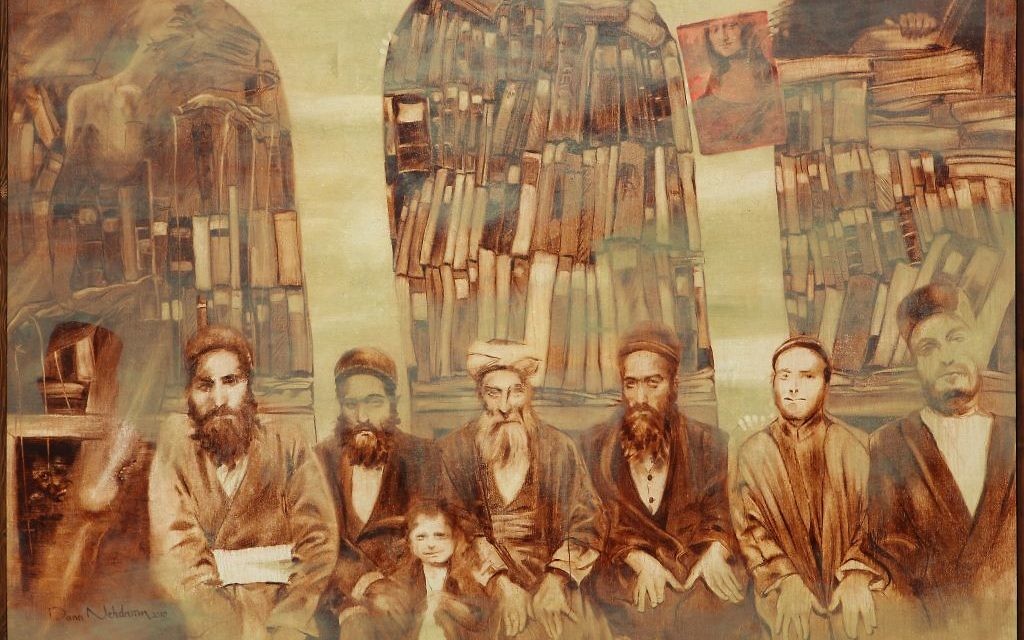Persian Artist Preserves Jewish Heritage
Jewish Iranian artist Dana Nehdaran uses modern objects in his paintings to connect the present and past.

Art is an addiction for Jewish Persian painter Dana Nehdaran as it is a platform to share his culture and connect the past and present.
His latest series, “Esther’s Children,” uses contemporary art to showcase people and faces highlighting his heritage.

Although Jews have a rich history in Iran reaching back into the Persian Empire, many people know no more than the story of Queen Esther, who delivered her people from Haman’s plot, a role celebrated by Jewish children and adults alike every Purim.
Get The AJT Newsletter by email and never miss our top stories Free Sign Up
The theme is also part of Jewish Iranian Houman Sarshar’s book “Esther’s Children,” which captures a collection of manuscripts, objects and portraits documenting Iranian Jews from their earliest settlement through the 20th century.
Nehdaran stumbled on the collection after his brother, Dariush, another family artist and noted photographer, brought the book home while studying for his thesis about Jewish symbolism in Iran.
“I was fascinated by the photos and wanted to learn more about the author and why Iran’s Jewish population has dissipated,” Nehdaran said.
He drew inspiration from the old photographs to create oil paintings in a series also titled “Esther’s Children.”
One of the fundamentals of contemporary art, Nehdaran said, is the ability to showcase a relationship connecting past, present and future. While working on his series, Nehdaran often felt that he was a part of the families he was painting and subconsciously substituted modern objects or faces into the canvases.

In Isfahan, Nehdaran frequently visited his grandparents’ home, adorned with antique portraits and gems that created his affinity toward art. But it was not until Nehdaran turned 9 that his mother discovered his innate talent and enrolled him in private classes under the tutelage of well-known artist Hassanpour.
After he graduated from high school, Nehdaran was accepted to Soureh Art University in Shiraz, where he studied rug designs and painting. He later moved to Tehran, where he painted full time and opened a series of solo and group exhibitions.
“I wanted to let people know that Jews and Muslims have been living alongside each other for centuries in Iran,” Nehdaran said. “You can’t distinguish an Iranian Jew from an Iranian Muslim walking down the street, and I thought it fit the series’ title well.”
Since its debut, “Esther’s Children” has traveled to Tehran, Dubai, Los Angeles and New York, drawing praise and debate from gallery owners and viewers.
In Tehran, Radio Israel (Sedayeh Iran) initially announced that it was thankful to have a young artist open a gallery reflecting his Jewish heritage, but the series received a backlash when rumors spread of a police raid after the gallery’s opening.
Nehdaran said the raid never occurred, however, and the book “Esther’s Children” has been published twice in Iran, albeit illegally.
Nehdaran’s exhibition went through a different experience in Dubai. The gallery’s owner requested that he omit the word “Jewish” when describing the tribe that immigrated to Iran during Darius’ reign over the Persian Empire.
“There were no other tribes which immigrated to Iran, however, other than Jews,” Nehdaran said. He added that the show sold out, including two paintings purchased by the Salsali Private Museum in Dubai.
Nehdaran’s latest project, a series called “Fe26,” portrays rustic buildings and subway terminals in New York. He uses real rust, water and art products to create a realistic look at the sites and their evolution when exposed to various conditions.
“The paintings are almost life like for me because I have to water and nurture them to help them come to life,” he said.
“Painting eventually becomes one’s profession, but for me it’s an addiction,” Nehdaran said. “I feel lost if I don’t paint. … Some of my best days are when my paintings are going the way I want … even if the process is a struggle.”




comments